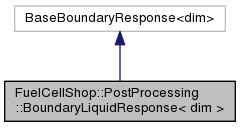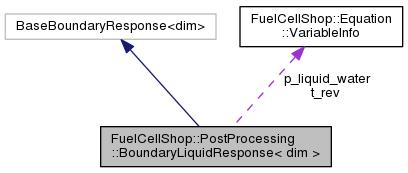|
OpenFCST: The open-source Fuel Cell Simulation Toolbox
|
|
OpenFCST: The open-source Fuel Cell Simulation Toolbox
|
Class used to calculate the boundary liquid flux through the boundaries (GDL) in the MEA model. More...
#include <response_water_capillary.h>


Public Member Functions | |
Constructor, declaration and initialization | |
| BoundaryLiquidResponse (const FuelCell::SystemManagement &sm) | |
| ~BoundaryLiquidResponse () | |
| void | declare_parameters (ParameterHandler ¶m) const |
| void | initialize (ParameterHandler ¶m) |
| Initialize class parameters. More... | |
Compute functional | |
| FuelCellShop::Equation::VariableInfo | p_liquid_water |
| VariableInfo structure corresponding to the capillary pressure. More... | |
| FuelCellShop::Equation::VariableInfo | t_rev |
| VariableInfo structure corresponding to the temperature. More... | |
| void | compute_responses (const typename DoFApplication< dim >::FaceInfo &bdry_info, FuelCellShop::Layer::BaseLayer< dim > *const layer, std::map< FuelCellShop::PostProcessing::ResponsesNames, double > &resp) const |
| This member function computes the volumetric current density produced inside the electrode due to the oxygen reduction reaction. More... | |
| void | compute_responses (std::vector< FuelCellShop::SolutionVariable > solution_variables, const typename DoFApplication< dim >::FaceInfo &bdry_info, std::map< FuelCellShop::PostProcessing::ResponsesNames, double > &resp) const |
| Routine used in order to compute the response with a modified solution (not the one stored in info) More... | |
Class used to calculate the boundary liquid flux through the boundaries (GDL) in the MEA model.
Note that this class will only work if an object of type gas diffusion layer is passed as an argument.
|
inline |
|
inline |
| void FuelCellShop::PostProcessing::BoundaryLiquidResponse< dim >::compute_responses | ( | const typename DoFApplication< dim >::FaceInfo & | bdry_info, |
| FuelCellShop::Layer::BaseLayer< dim > *const | layer, | ||
| std::map< FuelCellShop::PostProcessing::ResponsesNames, double > & | resp | ||
| ) | const |
This member function computes the volumetric current density produced inside the electrode due to the oxygen reduction reaction.
In order to compute the current density, the following functional is evaluated
![\[ I = int_{\Omega} i dV \]](form_484.png)
In addition, if the catalyst layer uses a kinetic model that provides coverages those values are also provided in the response parameter, i.e., resp.
In order to access the current produced at the electrode use:
The coverages are accessed using FuelCellShop::PostProcessing::ResponsesNames::O_coverage and FuelCellShop::PostProcessing::ResponsesNames::OH_coverage
| void FuelCellShop::PostProcessing::BoundaryLiquidResponse< dim >::compute_responses | ( | std::vector< FuelCellShop::SolutionVariable > | solution_variables, |
| const typename DoFApplication< dim >::FaceInfo & | bdry_info, | ||
| std::map< FuelCellShop::PostProcessing::ResponsesNames, double > & | resp | ||
| ) | const |
Routine used in order to compute the response with a modified solution (not the one stored in info)
| void FuelCellShop::PostProcessing::BoundaryLiquidResponse< dim >::declare_parameters | ( | ParameterHandler & | param | ) | const |
| void FuelCellShop::PostProcessing::BoundaryLiquidResponse< dim >::initialize | ( | ParameterHandler & | param | ) |
Initialize class parameters.
|
private |
VariableInfo structure corresponding to the capillary pressure.
|
private |
VariableInfo structure corresponding to the temperature.
 1.8.5
1.8.5